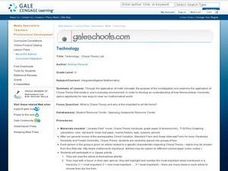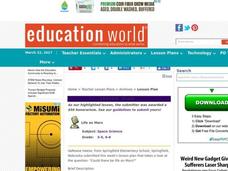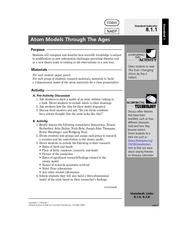Curated OER
Technology - Chaos Theory Lab
Ninth graders gain an understanding of Chaos Theory that exists in one's everyday environment.
Curated OER
Where Math Meets Poetry
Students identify Fibonacci's sequence of numbers and use the pattern to write poetry with one syllable words. For this math and writing lesson, students identify Fibonacci's sequence of numbers and learn about this early mathematician....
Curated OER
Architecture And Math
Students investigate the ties that architecture and math have in common. They focus on works of architecture in the world that is considered of great significance. Students use the internet to find building images from around the world....
Curated OER
Theoretical Quantum Physics... For Kids!
Learners explore quantum physics by participating in several class activities. In this space-time lesson, students discuss the concepts of time traveling and the anatomy of an atom. Learners draw geometric figures and utilize string to...
Curated OER
The Fibonacci Keyboard- Jazz and Math
Students demonstrate an understanding of the relationships of the Fibonacci Sequence. They apply the Fibonacci Sequence and find its relationship to a piano keyboard. They explore various relationships between music and the Fibonacci...
Curated OER
Metric Meals
Sixth graders investigate metric measurements. In this metric measurement lesson, 6th graders explore mass, capacity, and length. Students examine graduated cylinders and balance scales to obtain measurements. Resources are provided.
Curated OER
Life on Mars
Young scholars research the feasibility of life on Mars and debate what it would need in order to sustain life. They work in teams to predict, research, infer, and explain their theory using models they build.
Curated OER
Aeronautics: Bernoulli's Principle
Students explore physics by participating in a science activity in class. In this flight properties instructional activity, students identify Bernoulli's principle of flight and his theory of statics and motion. Students conduct a...
Curated OER
Time Travel, Black Holes, and Relativity
Learners read the novel, The Time Machine, and compare H.G. Well's perceptions of the future with those presented in The Third Wave, by Alvin Toffler. They research current scientific and mathematical theories that relate to space and time.
Curated OER
Swinging Pendulum
Middle schoolers engage in an activity which demonstrates how potential energy (PE) can be converted to kinetic energy (KE) and back again. Given a pendulum height, students calculate and predict how fast the pendulum will swing by...
Curated OER
Radiation Comparison Before and After 9-11
Using the NASA website, class members try to determine if changes could be detected in cloud cover, temperature, and/or radiation measurements due to the lack of contrails that resulted from the halt in air traffic after the attacks...
Curated OER
Building Bridges
Learners identify the different types of bridges. Using the internet, they research information on how they are built by completing a scavenger hunt. Locating a specific area, they determine which type of bridge would be appropriate and...
Curated OER
Let's Heat Things Up!
Students build and evaluate simple models to understand the greenhouse effect. They explore the role of increased greenhouse gas concentration in global warming, and the implications of global warming theory for engineers, themselves...
Curated OER
Art and Anatomy: The Vitruvian Teen
Twelfth graders create an artistic version of a Vetruvian teen. In this anatomy lesson plan, 12th graders design an experiment to test the theory of the ideally proportioned man. They present their findings in class.
Curated OER
Four Color Map
Students explore geometry by completing a color puzzle. In this shape identification lesson, students utilize deductive reasoning to complete a Google SketchUp puzzle with trapezoid, triangles and rectangular shapes. Students...
Curated OER
Multiple Intelligences
Students investigate Gardner's theory of multiple intelligences. In this research based lesson plan, students compare theories of intelligences and examine the implications of using these theories in schools and society.
Curated OER
Teaching about Increased Conductivity: Are Culverts The Culprits?
Students encounter the complexity of identifying the cause of unusual variations in WOW conductivity data. They propose theories on why there was a sudden increase in conductivity in Ice Lake, Minnesota during July of 1998.
Curated OER
Paint My Counties: Map Coloring the Counties of Arizona
Fourth graders identify the counties of Arizona. In this social studies lesson, 4th graders color a county map of Arizona using the fewest number of colors possible. Students write a persuasive paragraph.
Curated OER
Fractions in the Kitchen
Seventh graders use the World Wide Web for research, identify fractions found in everyday life by finding a recipe that uses fractions.
Curated OER
Atom Models Through the Ages
Eighth graders explain the development of the atomic model over time. In this chemistry lesson, 8th graders research about the scientists who made a contribution to the atomic theory. They create a three-dimensional model based on their...
Curated OER
Compare Human-made Objects with Natural Objects
Students examine and observe how many human-made objects get their basic design from things in nature. They listen to the book "Nature Got There First," compare/contrast hollow bones with drinking straws, bird beaks and tool pliers, and...
Curated OER
Dinosaurs - Creatures Of The Past
Young scholars use the Internet to search for dinosaurs, then distinguish between meat-eating and plant-eating dinosaurs. They explore theories about the extinction of dinosaurs and create illustrations of dinosaurs using Kid Pix or...
Curated OER
Different Perspectives of Oregon's Forest Economic Geography
Pupils map data on employment in wood products manufacturing in Oregon counties. In this Oregon forest activity, students discover the percentage of people employed in the forest manufacturing industry. Pupils create a box and whisker...
Curated OER
Archimedes' Principle of buoyancy
Students use the internet to research Archimedes' principle of buoyancy. In groups, they summarize the principle and share it with the class. They also participate in experiments in which they test the principle and share their results...























